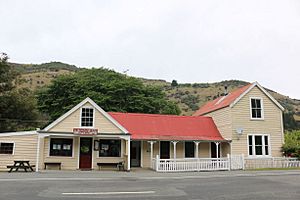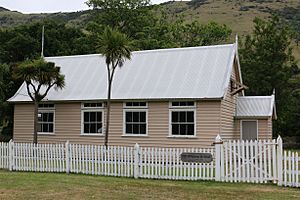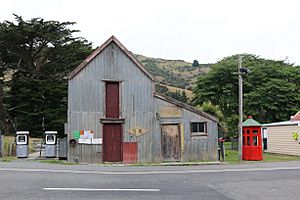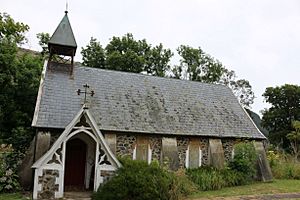Okains Bay facts for kids
Quick facts for kids
Okains Bay
|
|
|---|---|
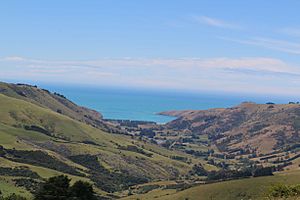
Okains Bay in December 2020
|
|
| Country | New Zealand |
| Region | Canterbury Region |
| District | Christchurch City |
| Ward | Banks Peninsula |
| Community | Te Pātaka o Rākaihautū Banks Peninsula |
| Electorates |
|
Okains Bay is a lovely settlement, beach, and bay in New Zealand. You can find it on the Banks Peninsula in the South Island. It's about 10 kilometers (6 miles) from Akaroa, the main town on the peninsula. From Christchurch, it's a 90-minute drive, about 86 kilometers away.
The sandy beach is a favorite spot for visitors. A river flows into the bay here. Okains Bay also has a special museum about Māori and early European life. There's a campground right by the beach, near where the river meets the sea. The beach is often quiet, and there's a big cave to explore at one end!
Contents
Okains Bay: A Place of History
Okains Bay has a rich history, important to both Māori and European settlers. It's a place where you can learn about the past.
Early Māori Settlement
In Māori, Okains Bay is known as Kawatea. This area is very important to the Ngāi Tahu people. A powerful chief named Moki built his Pa (a fortified village) here. This happened when the Ngāi Tahu moved to the Canterbury region.
Okains Bay is known as the first place the Ngāi Tahu landed on the Banks Peninsula. Scientists have found old items here. These items show that Māori people were living in Okains Bay as far back as the 1300s.
European Settlers Arrive
Okains Bay got its European name from Captain Hamilton. He was sailing past and reading a book by an Irish naturalist named Okain. Europeans first settled here around 1850.
By September 1850, the first pieces of land were sold to European settlers. Because there were no roads, people traveled by steamer boat. The boat went to Lyttelton, which was 21 miles away. It would stop at Little Akaloa along the way.
Industries and Trade
A large sawmill started working in 1874. Today, this building is used as a shearing shed for sheep. Wood from the sawmill was moved by a trolley line to the first wharf. This wharf was in the middle of the beach.
A cheese factory opened in 1894. It made cheese for many years before closing in 1968.
The Wharves of Okains Bay
Over time, three different wharves were built in Okains Bay. They helped boats dock and load goods. These wharves were used to transport many things. This included farm animals, meat, wool, timber, and dairy products. People also traveled by boat from these wharves.
The first two wharves stopped working because sand moved around them. The third wharf was closed and taken down in 1964. Its timber was then used to fix road bridges.
People of Okains Bay
Okains Bay is part of a larger area called Banks Peninsula Eastern Bays. This area covers about 368 square kilometers (142 square miles).
In 2018, the Eastern Bays-Banks Peninsula area had 615 people living there. The average age of people was 50.7 years. About 17.6% of the people were under 15 years old.
Most people living here were of European background (95.1%). About 12.2% identified as Māori.
Important Buildings in Okains Bay
Okains Bay has several notable buildings that tell its story.
The Māori and Colonial Museum
The museum used to be the old cheese factory. It was created thanks to Murray Thacker, a local resident. He loved collecting Māori treasures from the beaches when he was a child. The museum's collection is very important. It includes items like tiki (carved figures), fishing tools, weapons, and cloaks.
Tini Arapata Marae
The Tini Arapata marae is a special meeting place for Māori people. It was named by Aunty Jane Manahi, in honor of her mother, Tini Arapata Horau.
Okains School Building
The original Okains Bay school building was built in 1872. Children learned here until 1938.
Petrol Station
Okains Bay has a unique, rustic petrol station.
Okains Bay Store and Post Office
The local store and post office were built in 1873. They have served the community for a long time.
The Library
The library building in Okains Bay was built in 1865.
St John the Evangelist Anglican Church
This church was finished in June 1863. It was built by a stonemason named Mr. Morey. The stone and timber used for the church came from the local area. The slate roof and stained glass windows were brought from England.
In 1884, an organ was bought for the church. The church bell was given as a gift in 1912. In 1959, the floor started to crumble, so a new concrete floor was put in.
In 2020, this church was the second oldest stone church still standing in the Christchurch area. It was badly damaged by the earthquakes in Canterbury in 2010 and 2011.
See also
 In Spanish: Bahía de Okains para niños
In Spanish: Bahía de Okains para niños


